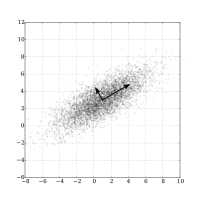
Photo from wikipedia
Objectives To investigate the application of apparent diffusion coefficient (ADC) histogram analysis in differentiating between benign and malignant breast lesions detected as non-mass enhancement on MRI. Materials and Methods A… Click to show full abstract
Objectives To investigate the application of apparent diffusion coefficient (ADC) histogram analysis in differentiating between benign and malignant breast lesions detected as non-mass enhancement on MRI. Materials and Methods A retrospective study was conducted for 25 malignant and 26 benign breast lesions showing non-mass enhancement on breast MRI. An experienced radiologist without prior knowledge of the pathological results drew a region of interest (ROI) outlining the periphery of each lesion on the ADC map. A histogram was then made for each lesion. Following a univariate analysis of 18 summary statistics values, we conducted statistical discrimination after hierarchical clustering using Ward’s method. A comparison between the malignant and the benign groups was made using multiple logistic regression analysis and the Mann-Whitney U test. A P -value of less than 0.05 was considered statistically significant. Results Univariate analysis for the 18 summary statistics values showed the malignant group had greater entropy (P < 0.001) and lower uniformity (P < 0.001). While there was no significant difference in mean and skewness values, the malignant group tended to show a lower mean (P = 0.090) and a higher skewness (P = 0.065). Hierarchical clustering of the 18 summary statistics values identified four values (10th percentile, entropy, skewness, and uniformity) of which the 10th percentile values were significantly lower for the malignant group (P = 0.035). Conclusions Whole-lesion ADC histogram analysis may be useful for differentiating malignant from benign lesions which show non-mass enhancement on breast MRI.
Journal Title: Journal of Clinical Imaging Science
Year Published: 2022
Link to full text (if available)
Share on Social Media: Sign Up to like & get
recommendations!